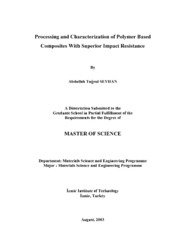Please use this identifier to cite or link to this item:
https://hdl.handle.net/11147/3466Full metadata record
| DC Field | Value | Language |
|---|---|---|
| dc.contributor.advisor | Tanoğlu, Metin | - |
| dc.contributor.author | Seyhan, Abdullah Tuğrul | - |
| dc.date.accessioned | 2014-07-22T13:51:35Z | - |
| dc.date.available | 2014-07-22T13:51:35Z | - |
| dc.date.issued | 2003 | - |
| dc.identifier.uri | http://hdl.handle.net/11147/3466 | - |
| dc.description | Thesis (Master)--Izmir Institute of Technology, Materials Science and Engineering, Izmir, 2002 | en_US |
| dc.description | Includes bibliographical references (leaves: 84-88) | en_US |
| dc.description | Text in English; Abstract: Turkish and English | en_US |
| dc.description | 88 leaves | en_US |
| dc.description.abstract | Fiber reinforced polymeric composite materials have recently gained widespread use in military, transportation, energy and civil engineering applications. Resin Transfer Molding (RTM) and Vacuum Assisted Resin Transfer Molding (VARTM) process have become important in the manufacture of these types of composites. In those techniques, use of fiber preforms offer some distinct advantages. Using thermoplastic binders that bond the fabrics together allows the plies to be consolidated into near net shape preform.In the present work, glass preforms were consolidated by application of heat and pressure over plies of the glass fabrics that were coated with various concentration of thermoplastic polyester binder. Composite laminates with and without binder were fabricated by utilizing VARTM technique. The peel strength of the preforms with various binder contents was measured to determine the optimum binder concentration. The highest peel strength was obtained from preforms that were prepared with about 9 wt.% of the binder. Preform compression test was also performed using universal test machine with preforms composed of eight plies of glass fabrics with binder (3,6 and 9 wt.%) and without binder. It was observed that the binder has significant effect on the degree of preform compaction. The highest thickness reduction and therefore fiber volume fraction of the preforms was reached via 3 wt.% of binder. The flexural strength and modulus, compressive strength and modulus through ply-lay up and in-plane loading directions, apparent interlaminar shear strength, mode I interlaminar fracture toughness of the composites with and without binder were measured to evaluate the effects of the binder on the mechanical properties of the composite plates. It was found that the flexural strength, mode I interlaminar fracture toughness of the E-glass/polyester composite system decreases 30 and 40 percentage, respectively due to the presence of 3 wt.% and 6 wt.% of binder. On the other hand, the flexural modulus of the composite increases while the apparent interlaminar shear strength remains almost constant by the introduction of the binder. The ply-lay up compressive strength and modulus were found to increase up to 3 wt.% of binder and decrease upon further addition of binder. The same findings are valid for the compressive strength and modulus through in-plane loading direction. Ballistic test was performed on E-glass/polyester composite panels according to NATO standards 2920 using 1.1-gr. fragment-simulating projectiles (FSPs) to evaluate the effects of the binder on the ballistic performance of the E-glass/polyester composite laminates. The ultrasonic C-scan test method was used to monitor the extent of the damage on the panels due to ballistic impact. It was seen that the damage on the ballistically impacted composite panels decreases with increasing binder. A model matrix material was prepared adding various concentrations of the binder to the reacting resin system in order to follow the extend of binder dissolution within the matrix resin. It was found that there is no complete dissolution of the binder in the matrix resin. | en_US |
| dc.language.iso | en | en_US |
| dc.publisher | Izmir Institute of Technology | en_US |
| dc.rights | info:eu-repo/semantics/openAccess | en_US |
| dc.subject.lcc | TA418.9.C6 S51 2003 | en |
| dc.subject.lcsh | Fibraus composites--Testing | en |
| dc.subject.lcsh | Polymeric composites | en |
| dc.subject.lcsh | Glass fibers | en |
| dc.title | Processing and Characterization of Polymer Based Composites With Superior Impact Resistance | en_US |
| dc.type | Master Thesis | en_US |
| dc.institutionauthor | Seyhan, Abdullah Tuğrul | - |
| dc.department | Thesis (Master)--İzmir Institute of Technology, Materials Science and Engineering | en_US |
| dc.relation.publicationcategory | Tez | en_US |
| dc.identifier.wosquality | N/A | - |
| dc.identifier.scopusquality | N/A | - |
| item.openairecristype | http://purl.org/coar/resource_type/c_18cf | - |
| item.languageiso639-1 | en | - |
| item.openairetype | Master Thesis | - |
| item.grantfulltext | open | - |
| item.fulltext | With Fulltext | - |
| item.cerifentitytype | Publications | - |
| Appears in Collections: | Master Degree / Yüksek Lisans Tezleri | |
Files in This Item:
| File | Description | Size | Format | |
|---|---|---|---|---|
| T000304.pdf | MasterThesis | 2.95 MB | Adobe PDF |  View/Open |
CORE Recommender
Page view(s)
244
checked on Mar 31, 2025
Download(s)
132
checked on Mar 31, 2025
Google ScholarTM
Check
Items in GCRIS Repository are protected by copyright, with all rights reserved, unless otherwise indicated.